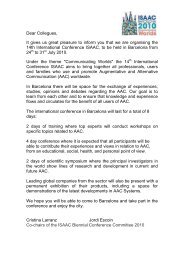May 2008 Edition - agosci
May 2008 Edition - agosci
May 2008 Edition - agosci
Create successful ePaper yourself
Turn your PDF publications into a flip-book with our unique Google optimized e-Paper software.
eviewsMovie ReviewThe Diving Bell and the Butterflyby Cathy Wilmottcathy.willmot@yooralla.com.au“I decided to stop pitying myself. Other than my eye, two things aren’t paralyzed, my imagination and mymemory” (Jean-Dominique Bauby, 1997).Based on Jean-Dominique Bauby’s 1997 memoirof the same name, “The Diving Bell and theButterfl y” (“Le Scaphandre et le Papillon”)by director Julian Schnabel, tells the story ofBauby’s experiences of life with locked-in syndrome.At age 43, Bauby, then editor-in-chief of the fashionmagazine “Elle”, suffers a devastating cerebral vascularaccident. Awakening from a coma, Bauby finds himselfimprisoned within a body he can no longer move orcontrol, but with a mind that remains free and unaffected.Thus, the metaphor of the heavy diving bell and the lightbutterfl y is used by Bauby to powerfully contrast the newactuality that is his body and mind.While locked-in syndrome dispossesses Bauby of hisability to communicate verbally, the relationship betweenthe viewer and his character quickly develops, as wealone are privy to Bauby’s incisive and often sardonicinner thoughts (subtitled for those of us who do notspeak French!). This intimacy is further heightened bythe fact that a significant portion of the film is shot fromBauby’s perspective. We, as the viewer, awaken in thehospital with Bauby to the confusion of blurred imagesand sounds, and when advised of the medical advancesand resources that have made it possible to save his life,it is only we who hear Bauby’s impassioned response“This is life!?”Through this sharing of perspective with the viewer, Schnabel is able to portray some of the moments of true horror detailed inBauby’s memoir. However, while these horrific moments do exist, they do not define Bauby’s existence, and are tempered by hisability to build beautiful images of his life, both real and imagined. There is loss, but there is also Bauby’s tenacious spirit anddetermination, which sees him accept the previously unimaginable, drawing strength from memories of his life before his stroke,and from the imagination which frees him from the confi nes of his body. It is this tenacity which sees him, with the assistanceof his speech pathologist, learn to communicate again with the outside world. Using his left eye (the only part of his body heis able to control after his stroke), Bauby painstakingly blinks messages letter by letter to his family, friends, and staff at thehospital where he is interned. It was this method that Bauby used over a period of 14 months to dictate the brilliant and moving“The Diving Bell and the Butterfl y”.The end result of Schnabel’s sensitive interpretation of Bauby’s text is a film that is extremely moving and engaging, whilemanaging to avoid degenerating into a condescending or saccharine retell of Bauby’s experience. “The Diving Bell and theButterfl y” is raw and authentic, it is as humorous as it is sobering, and at 112 minutes, it is well worth dedicating the time tobecome acquainted with the indomitable Jean-Dominique Bauby.Note: supplies of tissues and chocolate are highly recommended!41





